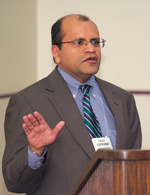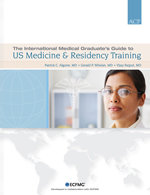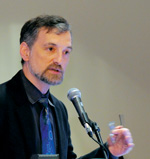IMGs get acculturation advice from a veteran
In an already overwhelming time period of residency, international medical graduates face extra burdens: confusing slang from patients, questioning authority when needed, and interacting with more knowledgeable subordinates. Cultural barriers have to be crossed to adapt to life in a U.S. residency.
Vijay Rajput, FACP, knows firsthand how difficult it is for an international medical graduate (IMG) to acculturate to U.S. medical practice.
His challenges began with his first patient on his first day of residency in the U.S., Dr. Rajput told attendees at the Internal Medicine 2010 session “Tools for IMGs to Succeed in Academic and Practice Settings.”

“It was a syncope patient and I asked ‘What happened?’ The patient said, ‘I passed out,’” Dr. Rajput described. He had never heard the term before. “I thought ‘passed out’ means you are dead,” he said. It didn't help when the patient elaborated on his history, explaining that before he passed out, he had thrown up. Throwing up was more new vocabulary for Dr. Rajput.
American slang is only one of the many obstacles facing a new IMG. Dr. Rajput and co-presenter Gerald P. Whelan, MD (along with Patrick C. Alguire, FACP) covered many of them in their recent book, The International Medical Graduate's Guide to US Medicine & Residency Training. During the session, they offered some of their advice, which could be useful to both IMGs and the physicians who train them.
Although the acculturation process is most intense at the start (“an emotional rollercoaster,” as Dr. Rajput put it), it will be lifelong, the experts warned. “I'm still getting a shock every day,” said Dr. Rajput.
Communication with peers
IMGs should deal with their uncertainty by admitting it, Dr. Rajput advised. “There's nothing wrong with asking people to clarify,” he said. Depending on their cultural background, however, it may be more difficult for some IMGs to admit their lack of understanding. “I was always really uncomfortable to say ‘I don't know,’” admitted Dr. Rajput. “Nowadays, I have a mantra that three times a day I should say ‘I don't know,’ and say ‘OK, I'll find out.’”
It can also be difficult to adapt to the idea that one's superior might not know the right answer, either. The acceptability of questioning the decisions of higher-ups is different in the U.S. from many other countries, according to Dr. Rajput. “Many of the IMGs will never doubt the judgment of the attending, and you should,” he said. “When I grew up, it was ‘Yes, sir,’ ‘No, sir,’ ‘Thank you.’ I think that's a pretty big change.”

That relationship continues down the hierarchy as well, and can pose issues for IMGs in their first interactions with nonphysician providers. “If the social worker tells you something, or the physical therapist tells you something, you get so angry. I remember those days,” said Dr. Rajput. “The biggest challenge if you are an IMG is to understand that a nonphysician may have more knowledge than you as an intern.”
IMGs may also struggle with how much of their own knowledge to bring to the task. It's a strength of IMGs that many of them have more extensive training than their U.S.-educated peers, said Dr. Rajput.
He, for example, was a surgeon with additional training in plastic surgery in India before he came to the U.S. and entered an internal medicine residency. But to get along in the U.S., he found it was sometimes better to keep quiet about his experience. The surgeon called by young Dr. Rajput to see a patient with likely appendicitis may not have appreciated diagnostic assistance from the medicine intern.
Cultural crosses
Dr. Rajput listed a few other areas in which IMGs commonly outshine their peers: strong work ethic, commitment to medicine, appreciation of their opportunities, respect for authority (“Sometimes it goes too far,” he noted) and strong family bonds.
But even that last trait can become a negative if it gets caught up in culture clash. Dr. Whelan gave the example of a person who runs into a cousin on the way to a meeting. In a very family-centric culture, the proper behavior is to stop and catch up with the family member, even if it makes you late for the meeting. “In American society, which is much more individualistic, it's more appropriate to say, ‘I can't talk to you now, I have this meeting,’” noted Dr. Whelan.
Talking with patients
There are also things to learn about the interactions between doctors and patients, especially the importance of patient autonomy in the U.S. “It takes a long time to let patients make their own decision. It took me a lot of time to understand that,” said Dr. Rajput. IMGs are often strongest on the information-gathering aspect of the patient encounter, but weaker on patient education and relationship building, he added.
As unrelated to medicine as it sounds, some knowledge of local popular culture can help with building a relationship. “I don't care for cricket anymore. I do care whether Donovan McNabb is going from the Eagles to the Redskins because I [can] have a conversation with a patient about that,” said Dr. Rajput.
Whatever the topic, it's also important to adapt your conversational style to norms like making eye contact. “I don't care where you grew up, and if you never made eye contact with your grandfather or father. If you're in a U.S. residency, you'd better make eye contact,” said Dr. Rajput.
Other, less tangible aspects of communication can also pose challenges. “It took me many years to understand what is the difference between privacy and confidentiality,” he said.
Professionalism
Another piece of vocabulary that Dr. Rajput hadn't been acquainted with could have major academic repercussions. “I didn't even know the word plagiarism until I came to this country. It takes a long time for an IMG to understand that you cannot cut and paste anything from Google into your abstract,” he said.
Many of these issues are components of medical professionalism, a topic that may not have been as thoroughly covered in foreign medical schools. “When I came through medical school in the early ‘80s, I had zero lectures on professionalism or ethics. We didn't get any training, not a single word,” said Dr. Rajput.
His lecture, of course, could cover only a small piece of the training that IMGs may need for really effective practice in the U.S. “I'm not saying all of this can be learned in a day or a month. I'm still learning,” he said.
Additional help is available from the organization for which Dr. Whelan works: the Educational Commission for Foreign Medical Graduates (ECFMG). For the past two years, he has directed the ECFMG's acculturation program.
“We are trying to focus on what we can do to make the transition for international graduates arriving in the U.S. a little bit easier and smoother,” he explained. That includes an advisor network, in which IMGs who are current residents or residency graduates communicate one-on-one with new arrivals.
The Web site for the organization also offers some training videos, which can be viewed individually or presented to groups, and a customizable survival guide for residency directors or anyone else orienting an IMG. “It allows you to put in the local information—where is your post office, what's the name of the phone company, and those kinds of things,” said Dr. Whelan.
With these resources and some effort, a fruitful American medical career can be achieved, Dr. Rajput reassured his audience of mostly IMG residents. “You may have to work a little more and longer. At the end of the day, if you have a good work ethic and you do the right thing, you can be successful,” he said.




